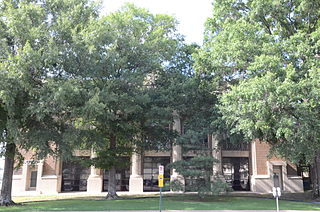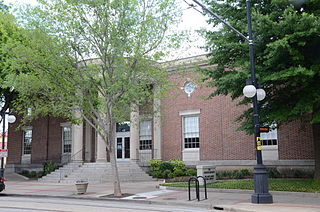
The Old State House Museum, formerly called the Arkansas State House, is the oldest surviving capitol building west of the Mississippi River. It was the site of the 1861 secession debate, as well as the 1868 Constitutional Convention when delegates agreed to ensure voting rights for freedmen and establish public schools.

The Governor's Mansion Historic District is a historic district covering a large historic neighborhood of Little Rock, Arkansas. It was listed on the National Register of Historic Places in 1978 and its borders were increased in 1988 and again in 2002. The district is notable for the large number of well-preserved late 19th and early 20th-century houses, and includes a major cross-section of residential architecture designed by the noted Little Rock architect Charles L. Thompson. It is the oldest city neighborhood to retain its residential character.

The BPOE Elks Club is a historic social club meeting house at 4th and Scott Streets in Little Rock, Arkansas. It is a handsome three-story brick building, with Renaissance Revival features. It was built in 1908 to a design by Theo Saunders. Its flat roof has an extended cornice supported by slender brackets, and its main entrance is set in an elaborate round-arch opening with a recessed porch on the second level above. Ground-floor windows are set in rounded arches, and are multi-section, while second-floor windows are rectangular, set above decorative aprons supported by brackets.

Central Presbyterian Church of Little Rock was started in 2014, and is a church plant of the Presbyterian Church in America. It is located in the Hillcrest area of Little Rock.

The Exchange Bank Building is a historic commercial building at 423 Main Street in Little Rock, Arkansas. It is a five-story masonry structure, built in 1921 out of reinforced concrete, brick, limestone, and granite. It has Classical Revival, with its main facade dominated by massive engaged fluted Doric columns. It was designed by the noted Arkansas architectural firm of Thompson & Harding, and is considered one of its best commercial designs.

The Gazette Building in Little Rock, Arkansas was built in 1908. It was designed by architect George R. Mann, and built by Peter Hotze. The building was listed on the U.S. National Register of Historic Places in 1976. Originally and for many years, the building served as the headquarters of the Arkansas Gazette newspaper. Its historic building in downtown Little Rock served as the national campaign headquarters for the 1992 presidential campaign of Governor Bill Clinton. It now houses the Elementary and Middle Schools for eStem Public Charter Schools.

The Arkansas Power and Light Building is a building in the city of Little Rock, Arkansas. The building is listed in the National Register of Historic Places. Now also known as the Entergy Building, it was the first office building in downtown Little Rock built in the International style. Designed by the architect Fred Arnold of the Little Rock architectural firm of Wittenberg, Deloney and Davidson in 1953, it was not completed until 1959 due to uncertainty over the utility's requested rate increases and the expiration of laborers' union contracts.

The Hot Springs Federal Courthouse is located at 100 Reserve Street in Hot Springs, Arkansas. It is a three-story building, with a steel frame clad in orange brick, with porcelain panels and aluminum-clad windows. It was designed by the Little Rock firm Wittenberg, Delony & Davidson, and was built in 1959-60 on the site of the Eastman Hotel, once one of the city's largest spa hotels. It is one of the city's best examples of commercial International architecture.

The Old Little Rock Central Fire Station is a historic firehouse, next to Little Rock City Hall at 520 West Markham Street in downtown Little Rock, Arkansas. It is, from its front, a Beaux Arts two-story masonry building, designed by Charles L. Thompson and built in 1913. The front facade is dominated by the former equipment bays, which are separated by fluted columns, and topped by an elaborate architrave. The building is now used for other purposes by the city.

Little Rock City Hall, the seat of municipal government of the city of Little Rock, Arkansas, is located at 500 West Markham Street, in the city's downtown. It is a Renaissance Revival structure, designed by Arkansas architect Charles L. Thompson and built in 1907. Its main facade has a projecting Roman portico, supported by fluted Ionic columns, with flanking sections that have Roman-style round-arch openings. The building housed most of the city's departments until the 1950s.

The George R. Mann Building, also known as the Adkins Building, is a historic commercial building at 115 East 5th Street in Little Rock, Arkansas. Built in 1906 to a design by local architect George R. Mann, it is an important local example of Beaux Arts architecture, and served as the site of Mann's office until 1912. It also served as an office for other notable Little Rock professionals such as Dr. Frank Visonhaler, Dr. E. R. Dibrell and Dr. M. E. McCaskilI. Despite the building's comparatively modest scale, it has a monumental-appearing facade, with two-story fluted columns set on paneled stone posts, with angled Ionic capitals supporting a heavily carved entablature. A line of dentil moulding separates that from a projecting modillioned cornice topped by a series of cartouches, with a recessed parapet behind.

The Argenta Branch Library is a branch of the public library system of North Little Rock, Arkansas. It is located at 420 North Main Street, in the former North Little Rock Post Office building, a brick Georgian Revival building constructed in 1931 to a design by Arkansas architect Charles L. Thompson. It was used as a post office until 2011, and was opened as a branch library in 2014.

The Roselawn Memorial Park Gatehouse is a historic cemetery office building in Roselawn Memorial Park, a large public cemetery at 2801 Asher Avenue in Little Rock, Arkansas. It stands just inside and to the left of the main gate. It is a single story building, with a gable-on-hip roof, stuccoed walls, and a foundation whose exterior is finished in rough cobblestone. At either end of its main facade are two arches, lined with red brick, providing access to the recessed building entrances. Similar arches on the side walls give the recess a porch-like feel. The building was designed by Thompson and Harding, and built in 1924. It is the only known gatehouse design of firms associated with Arkansas architect Charles L. Thompson.

The South Main Street Apartments Historic District encompasses a pair of identical Colonial Revival apartment houses at 2209 and 2213 Main Street in Little Rock, Arkansas. Both are two-story four-unit buildings, finished in a brick veneer and topped by a dormered hip roof. They were built in 1941, and are among the first buildings in the city to be built with funding assistance from the Federal Housing Administration. They were designed by the Little Rock firm of Bruggeman, Swaim & Allen.

The Tower Building is a commercial eighteen-story skyscraper at 323 Center Street in downtown Little Rock, Arkansas. Built in 1959-60, it was the tallest building in the state at the time of its completion, and the state's first instance of composite steel frame construction. It was designed by Little Rock architect F. Eugene Withrow and Dallas, Texas architect Harold A. Berry in the International style. It has curtain walls of windows on its north and south facades, and blank brick walls on the east and west, with the elevator tower projecting from its southern facade.

The Wallace Building is a nine-story commercial skyscraper at 101-11 Main Street in downtown Little Rock, Arkansas. It was built in 1928 to a design by Little Rock architect George R. Mann, and is an excellent local example of early Art Deco architecture. It was built by George Washington Donaghey, a former Governor of Arkansas; Mann and Donaghey had previously worked together on the Arkansas State Capitol, with disputes over its construction propelling Donaghey into politics and the governor's seat. This building is named after his wife's maiden name.

The YMCA–Democrat Building is a historic commercial building at East Capitol and Scott Streets in downtown Little Rock, Arkansas. It is a three-story masonry structure, built out of brick with molded stone trim. Built in 1904, its restrained Renaissance Revival designs have been obscured to some extent by later alterations. It was designed by Sanders & Gibb, a prominent local architectural firm, and originally housed the local YMCA before later becoming home to the Arkansas Democrat-Gazette, one of the state's leading newspapers.

The Stebbins and Roberts Office Building and Factory is a historic manufacturing facility at 1300 East 6th Street in Little Rock, Arkansas. Set on 3 acres (1.2 ha) at the junction of East 6th and Shall Avenue, the building has a single-story office section and a two-story manufacturing facility behind. It has a buff brick exterior, and its main entrance has Art Deco decorative elements. The plant was built in 1947 to a design by Burks and Anderson, a prominent local architectural firm. It is their only known surviving industrial design.

The Jesse Powell Towers are a residential apartment highrise at 1010 Wolfe Street in Little Rock, Arkansas. Built in 1975, it is a nine-story skyscraper, with a steel frame clad in brick and concrete, housing 169 residential units. It was designed by Stowers & Stowers for the city as public senior housing, and exemplifies a design principle espoused by Le Corbusier known as the "tower in a park", with a large landscaped green area surrounding the building.

The Darragh Building, also known as the DARCO Building, is a historic commercial building at 1403 East 6th Street in Little Rock, Arkansas. It is a single-story building with an office component and a warehouse component. The office component is built using modern post and beam construction, and has walls composed of concrete panel and floor-to-ceiling windows. Both it and its stairs are set on recessed platforms, giving it the appearance that it is floating. It was built in 1958 to a design by Noland Blass, Jr., and is a good example of Mid-Century Modern commercial architecture.

























